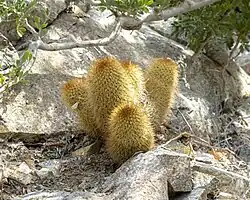Cochemiea cerralboa
| Cochemiea cerralboa | |
|---|---|

| |
| In habitat on Cerralvo Island | |
| Scientific classification | |
| Kingdom: | Plantae |
| Clade: | Tracheophytes |
| Clade: | Angiosperms |
| Clade: | Eudicots |
| Order: | Caryophyllales |
| Family: | Cactaceae |
| Subfamily: | Cactoideae |
| Genus: | Cochemiea |
| Species: | C. cerralboa
|
| Binomial name | |
| Cochemiea cerralboa (Britton & Rose) P.B.Breslin & Majure
| |
| Synonyms[2] | |
|
List
| |
Cochemiea cerralboa is a rare species of cactus in the genus Cochemiea commonly known as the Cerralvo nipple cactus. It is only found on Cerralvo Island in Baja California Sur, Mexico.[3]
Description
Cochemiea cerralboa typically grows solitary and rarely forms groups. Its slender cylindrical shoots reach up to 20 cm (7.9 in) in height and 3 to 4 cm (1.2 to 1.6 in) in diameter. The yellowish-green warts are firm, conical to cylindrical, and lack milky juice. Axillae have short bristles. The plant features a strong, straight or sometimes hooked yellowish central spine, 1 to 2 cm (0.39 to 0.79 in) long, and about 10 yellow, straight radial spines, each up to 2 cm (0.79 in) long.
The funnel-shaped flowers are white with pinkish-brown central stripes, up to 2 cm (0.79 in) long and wide. The club-shaped fruits vary from greenish to purple-red and contain black seeds.[4]
Taxonomy
It was first described as Neomammillaria cerralboa by Nathaniel Lord Britton and Joseph Nelson Rose in 1923.[5] In 2021, Peter B. Breslin and Lucas C. Majure reclassified it into the genus Cochemiea.[6]
Distribution
Cochemiea cerralboa is endemic to Cerralvo Island, the southernmost island in the Gulf of California, belonging to the state of Baja California Sur in Mexico.[3]
References
- ^ León de la Luz, J.L.; Gómez-Hinostrosa, C.; Hernández, H.M. (2017) [amended version of 2013 assessment]. "Mammillaria cerralboa". IUCN Red List of Threatened Species. 2017: e.T152267A121529247. doi:10.2305/IUCN.UK.2017-3.RLTS.T152267A121529247.en.
- ^ "Cochemiea cerralboa (Britton & Rose) P.B.Breslin & Majure". Plants of the World Online. Royal Botanic Gardens, Kew. Retrieved 2024-06-13.
- ^ a b Rebman, Jon P.; Gibson, Judy; Rich, Karen (15 November 2016). "Annotated Checklist of the Vascular Plants of Baja California, Mexico" (PDF). Proceedings of the San Diego Society of Natural History. 45. San Diego Natural History Museum: 107 – via San Diego Plant Atlas.
- ^ Anderson, Edward F. (2011). Das große Kakteen-Lexikon (in German). Stuttgart (Hohenheim): Ulmer. p. 375. ISBN 978-3-8001-5964-2.
- ^ Britton, Nathaniel Lord; Eaton, Mary E.; Rose, J. N.; Wood, Helen Adelaide (1919). The Cactaceae : descriptions and illustrations of plants of the cactus family. Washington: Carnegie Institution of Washington. doi:10.5962/bhl.title.46288.
- ^ Breslin, Peter B.; Wojciechowski, Martin F.; Majure, Lucas C. (2021). "Molecular phylogeny of the Mammilloid clade (Cactaceae) resolves the monophyly of Mammillaria". Taxon. 70 (2): 308–323. doi:10.1002/tax.12451. ISSN 0040-0262.
